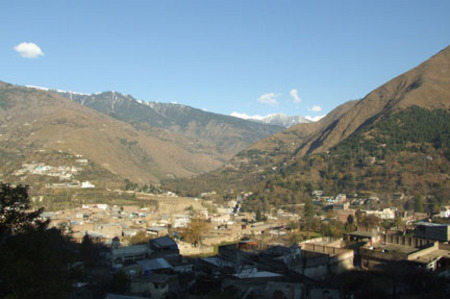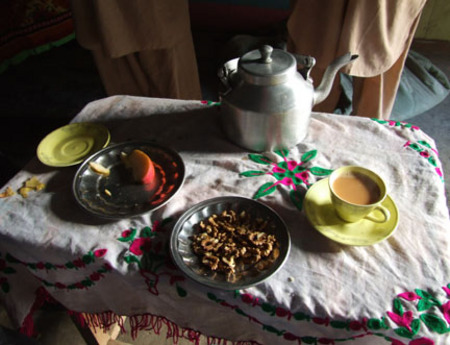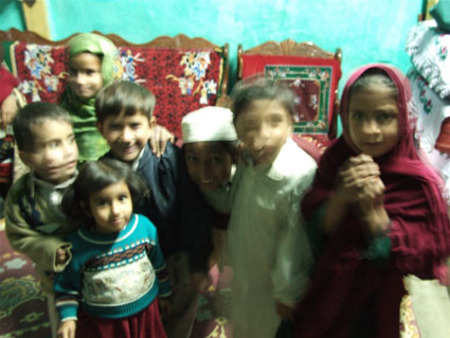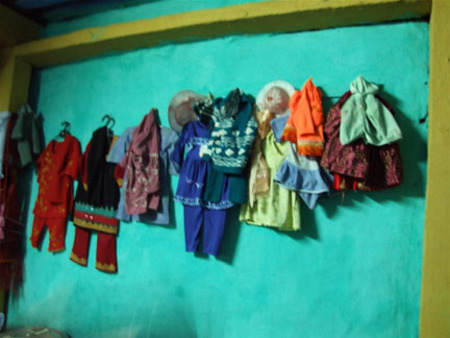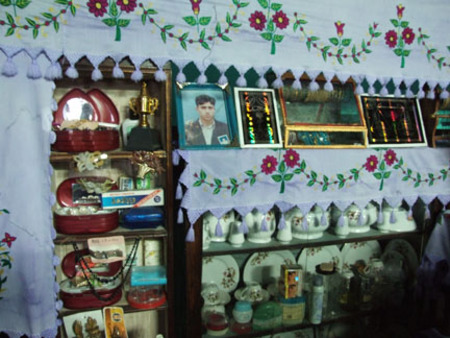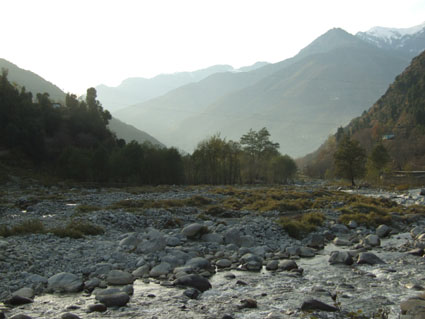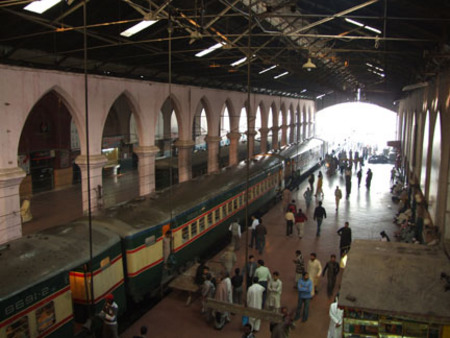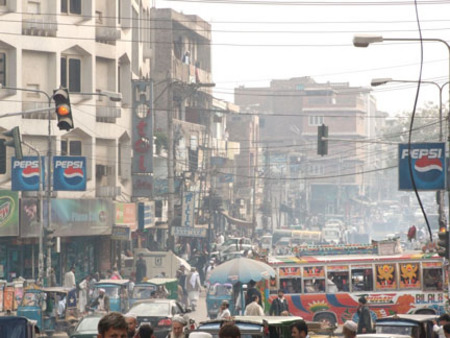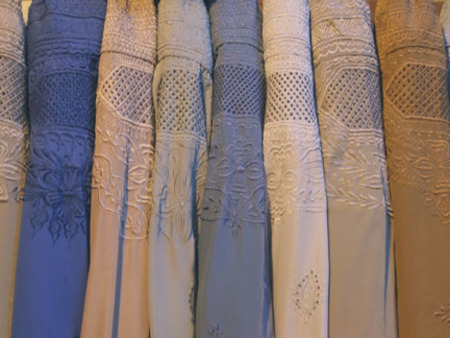Tabitha Moses
Residency at Beaconhouse National University
Clean fresh air and cups of tea
Posted by Tabitha Moses on 13th December 2006
...(next day. Blog interrupted by the energising visit of the HAT Project team).
I arrived in the mountain village of Madyan after dark and was led to Caravan Guesthouse (click here to visit their website) where I was welcomed with home-cooked food and a real fire. After a night's sleep under hand made quilts I woke to a sunny chilly day and a fantastic view of the village and the snow-capped mountains beyond.
The following three days were spent visiting neighbouring farming villages, guided by Hazrat Ali the tourist policeman. There is no road access to many of these villages and people walk the precarious paths along the valley, up and down the mountainside. On the way we encountered men carrying huge bundles of straw or firewood, other men chopping firewood, women carrying water (collected from the river) in metal containers on their heads, men herding goats, donkeys laden with goods for market. Many people asked us into their homes for a cup of tea or lunch. We accepted several offers and were fed local apples, persimmons, walnuts, honey and hot sweet tea. One old man, on our turning down his offer of lunch, walked back home to fetch a bag of fruit to sustain us on our journey.
It was like walking through a National Geographic photo spread where we drank clear mountain water from the river and ate fruit plucked from trees at the wayside. In many ways it seemed idyllic - these valleys in which the air is clean and fresh, crops are organically grown and hand processed, electricity generators and flour mills are powered by the river, where walking is the main form of transport, food is home made and strangers are treated as guests. However, it is a labour intensive, physically demanding existence and while many children attend the local school, just as many spend their days working on the farms. And, although electricity is generated by the river, I wonder at the impact of the widespread use of local wood for fires and stoves. I'd like to have had conversations with people about their lives and feelings, but language differences and time constraints kept our talk small (my smattering of Urdu was no use here. The local language is Kohistani, a few words of which where included in my Pakistan guide book. Thankyou Lonely Planet).
On several occasions I was privileged to be invited into the heart of the house, the kitchen and family rooms where females are out of sight of the visiting men. This is where I would meet the women and children. We'd sit and look and smile, obviously enchanted with each other and longing to connect. These visits also afforded glimpses at domestic treasures - shelves full of aluminium cookware, household linens decorated with hand embroidery, brightly painted walls and doors, black and white photographs of brothers and uncles, plastic flower garlands, wood burning cooking stoves, brightly coloured clothes, crocheted blankets and hand made quilts.
I have been struck by the fact that people have such intimate relationships with the objects they use - making, mending, adapting or decorating the everyday things around them, often by hand (this is much more common in Pakistan than in Britain. I like what HAT project manager, Jeremy Theophilus, has to say on this subject - he talks of 'the presence of the hand as an essential cultural force' in South Asia - click here to read his writing). It was especially, and unexpectedly, heartening to see embroidery playing a central role in peoples' lives - its use for decoration or adornment (of home, clothes and animals), as a mode of cultural expression and as a vehicle for continuity and connection with the long line of women who went before. The embroidery is tangible evidence of long evenings spent in quiet occupation, with no television or email to distract. As a fellow embroiderer, repairer and lover of the hand made I feel like something of an anomaly among my peers in Britain, so it was a joy to share this appreciation with the women I encountered.
I departed Madyan with a renewed sense of the importance of the hand crafted and a yen to return and spend the winter.
(Click here to see more pictures of Swat Valley)
Adventures up North
Posted by Tabitha Moses on 12th December 2006
It's been a busy few weeks. I spent 10 days in Peshawar and Swat Valley last month. I'd been getting mixed advice about travelling alone in Pakistan. Most people I asked were really cautious and advised against it. The guy at the travellers' hostel said I'd be fine, so I decided to take his word and booked my train journey north.
(Independent travel has been a major issue for me - around Lahore and beyond. Within Lahore rickshaw travel is fine (if fumey) but the rupees soon mount up, so I was overjoyed to discover that the Daewoo bus number 5 runs between the guesthouse and city centre).
So, after promising everyone I'd be careful, I set out on my adventure.
After a 10 hour train journey I arrived in Peshawar, which I liked immediately. The hotel was in a great location at a busy crossroads, a short walk from the bazaars of the old city.
Peshawar is near the border with Afghanistan and there are many refugees in the city (with a camp on the outskirts). I wandered around, drinking green tea and chatting with the Afghan shop workers, eating delicious Afghan food, experiencing the famous Pashtun hospitality, drooling over textiles and embroidery and wearing a large black scarf to cover my hair and body (and camera bag). I was delighted and thoroughly charmed by the people I encountered.
There are less women evident on the streets here, and those that are wear their hair covered. Most women wear burqas of the (blue pleated) Afghan or (variously coloured) Pakistani variety. After trying some on at the burqa shop I bought three.
I've been interested in this iconic and (to me) mysterious form of dress since seeing a beautifully embroidered example in the V&A 15 years ago. The aesthetic qualities, the symbolic and religious aspects, the feel of wearing it and the differing perceptions of a burqa-clad woman - all combine to make this a potent item of clothing, rich in meaning. Veiling is a public extension of the rules which govern the interaction between women and men within the home (where women are only seen by male members of their own family) and it is fascinating to discover more about these traditions.
After 3 days in Peshawar I took a packed minibus to Madyan in the valley of Swat. Just turning up at the (seemingly) chaotic bus stand and managing to get on the correct bus feels like an achievement. It is a bit daunting with no Urdu, but people are so kind and will go out of their way to help.
(Travelling on public transport has afforded me opportunities to interact with women - always ending up in conversations about my country, marriage and children (enthusiastic but limited by our language differences). I have felt a real emotional warmth and, generally, people seem to be considerate of the greater good in a way we are not in individualistic Britain, eg. by moving up to fit three people on a seat designed for two, insisting others sit down. People are also less precious about personal space and willing to share both space and food.)
More on Swat after I've had a cup of tea...
(Click here to see more images of Peshawar)
The Old City
Posted by Tabitha Moses on 10th November 2006
This week I met up with Michael, a Christian Pakistani guide and native of Lahore's Old City (or Walled City, though few of the original walls remain). We spent the day exploring. Just walking through the streets is so interesting. Everywhere you look there is a photograph waiting to be taken, but words and pictures cannot adequately convey the sense of being there. You don't get the sounds of the motorbike, rickshaw and car horns, the smells of spices, sewers, exhaust fumes, cooking, the sensation of squeezing between moving vehicles, stalls and animals, avoiding puddles, holes, cow, sheep, horse or goat dung, mounds of earth and bricks (construction happens all around), sounds of men calling their wares, the occasional radio blasting out Pakistani music, seeing interesting details from the corner of your eye, the jumble of architectural styles (Moghul, Sikh and English, along with modern concrete constructions), higgledy piggledy old buildings leaning towards each other, cracked and bulging walls, delapidated ornate wooden balconies, beautiful carved wooden gates, glimpses into shady rooms where all sorts of activities take place, but mostly things being made by hand, Michael pointing out the occasional madrassa, mosque, Sufi shrine or ex-Hindu temple, and trying to drink in these sights, smells and sounds all at once. Different parts of the Old City are devoted to specific bazaars, so there is a street for musical instruments, wedding coaches, traditional footwear, modern footwear, shoemaking equipment, sequinned wedding fabric, embroidery supplies, toys, bangles, gold jewellery, silver jewellery, dried fruit, kitchenware, and more. Shops selling, and making, knives and scissors, sweets, fried snacks and milk are found throughout. Also, the small tea stalls and tandoor clay ovens where flat breads are made. This was an inspiring day. Click here to see some pictures.
Does anyone ever read these things?
Posted by Tabitha Moses on 31st October 2006
So they've asked me to write a weblog. This is my first and I wonder at its purpose. Is it supposed to be a diary? A postcard home? A critical study? A conversation?
Should it be coolly intellectual or embarrassingly personal? A thoughtful reflection or spontaneous response?
Who am I writing to? Who am I writing for? And does anyone ever read these things anyway?
I suppose I'll write it for myself, and it'll probably be most of the above at one time or another.
So...here I am in Beaconhouse University City Campus computer lab, surrounded by excitable young students practising their Adobe Illustrator. I've been away from the UK for three weeks now and am just starting to feel settled. It took a while to sort out practical things like a studio space and internet access - knowing who to ask, etc. I (along with Chatwin and Martin) am based an hour away from central Lahore at the Tarogil Campus. I arrived right in the middle of the month of Ramzan (Ramadan), so the work day ended at 2pm which was rather disrupting.
I have also been confronted with unexpected doubts about my intentions. I came with an agenda which would have made for an unsophisticated and patronising response to the complex Pakistani society. Actually, it was a response to the limited British media coverage I had been exposed to. I realise that now.
So I arrived and felt rather paralysed for the first two weeks. Paralysis caused by a mixture of post-colonial guilt and an ignorance of the subtleties of the cultural language. An ignorance of the cultural language, full stop, never mind the subtleties. Basically, I didn't want to start making uninformed judgements and pronouncements in my work.
I also felt a pressure to get making. I am feeling very inspired - new ideas pop up every day. There is so much to take in, so much visual excitement and novelty, so many potential avenues of exploration, three months feels far too short a time to really delve into the possibitities. So I am eager to start making, thinking with my hands as well as my head. However, I think this spongy period of soaking up is valuable too.
I spent the Eid holiday (a week) in India - Amritsar (for Diwali) and Delhi. That was interesting (for various reasons, more of which another time) and it feels good to come back, full of renewed enthusiasm. Lahore is now home and I feel that break was important in helping me feel settled here.
I could go on for ages, so I'll stop writing now and just let you see the pictures (in the 'images' section).

Click on image to open QuickTime movie
"ARTIST'S TALK"
Tabitha Moses talks to conference during cHAT week at Sanskriti, Delhi, India. March 2007



